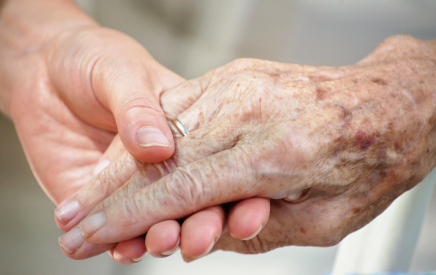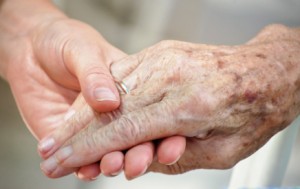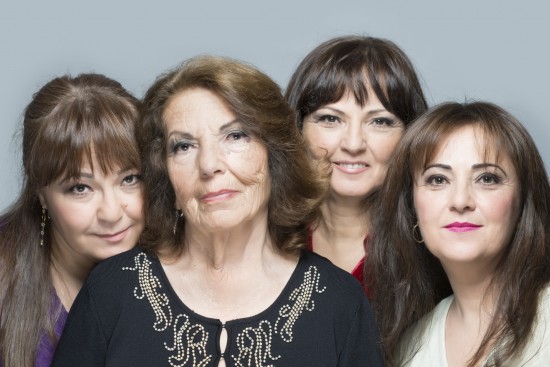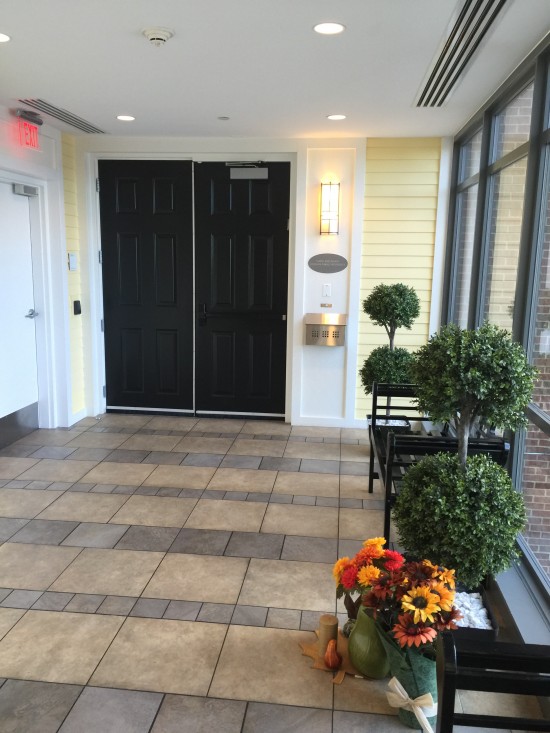Category: End of life
Posted by Dr. El - November 9, 2019 - End of life, Engaging with families, McKnight's Long-Term Care News


The holiday season will soon be upon us and with it will come out-of-town family members visiting their loved ones in long-term care settings.
Early November is a good time to increase the focus and training on customer service so that the facility is performing at its best when those infrequent but important guests arrive. It’s also a suitable moment to consider how to best aid families in discussing end-of-life care for their aging relatives.
Visitors who haven’t seen loved ones in several months may notice a physical or cognitive decline, making them more aware that life’s end is approaching. The holidays are also a time when several family members may be together and can discuss end-of-life concerns in collaboration.
While many residents will have completed advance directives upon admission, there are others who haven’t done so and those whose desires have changed. In addition, there are other details that may need addressing, such as readiness for hospice care, funeral arrangements, a last effort to repair fractured relationships or a chance to say good-bye.
Families invariably need assistance with these conversations and, as those who provide care to the ill and dying, this is a good opportunity to showcase the organization’s compassion and expertise in this area.
For the entire article, visit:
Posted by Dr. El - April 13, 2018 - Business Strategies, Communication, Customer service, End of life, Engaging with families, McKnight's Long-Term Care News, Resident care, Stress/Crisis management, Transitions in care

Here’s my latest article on McKnight’s Long-Term Care News:

In one of the more disturbing encounters I’ve had in long-term care — in a 5-Star deficiency-free nursing home — I offered my condolences to an aide on the loss of a resident she’d cared for over a period of two years.
The aide, a heavyset woman, smiled as she told me that she’d known the resident was dying and had urged the nurse to send her to the hospital quickly. The reason? She didn’t want to wrap the body of the equally heavyset resident after she died.
The resident died among strangers in an ambulance on the way to the hospital.
While I’d like to think the incident was an anomaly, I suspect many if not most nursing homes lack a mission statement for end-of-life care and that most teams can be better prepared for the last months and days of their residents.
Without leadership and training, disorganization and staff priorities can derail the care philosophy of the facility.
Providing decent end-of-life care is more than determining if a resident is DNR or full code. It includes recognizing that someone may be nearing the end of life, referring him or her to hospice while they’re most able to benefit from it, communicating regularly with the resident and their family about their needs, and treating the dying person, their remains and their belongings with respect.
Impact on families
Incidents such as the one above reflect poorly on the organization, even if family members don’t realize that it could have been averted with proper staff training. We often hear how important it is to make a good first impression, but as community institutions relying on reputation and referrals, it’s also essential to make a good last impression.
I’ve heard family members comment that they hadn’t always been pleased with the care at the home but they felt that their mother’s death had been handled with great respect. They left with a feeling of overall satisfaction.
Other families had been reasonably satisfied all along, but departed from the facility in shocked dismay at the end of their parent’s life at the poor communication, insufficient pain management and casual disregard for the belongings of the deceased.
Resident impact
Residents are closely observing how their neighbors’ deaths are handled because they know that this is how they will be treated when their time comes. Based on my experience, the things they find most disturbing are inadequate pain management, unacknowledged deaths and seeing the belongings of their friends removed in clear plastic garbage bags rather than in labeled boxes. They find it most comforting when they see that patients are referred to hospice, surrounded by loved ones, sleeping calmly through the night and when there’s a discussion of the loss among the residents, staff and chaplaincy.
Staff impact
The ways in which facilities handle deaths can have a big impact on staff members as well. As I suggest in “Absenteeism and turnover? Death anxiety could be the cause,” lack of attention to the experience of staff members in handling loss can contribute to employee turnover.
For the entire article, visit:


Posted by Dr. El - December 7, 2017 - Anecdotes, End of life, McKnight's Long-Term Care News, Personal Reflections

Here’s my latest article on McKnight’s Long-Term Care News:

I lost one of my two mothers-in-law last Monday, five weeks after she was diagnosed with pancreatic cancer. We had expected Audrey to reach 100 years of age, like her mother, but she died shortly after her 91st birthday, having spent her 90th year traveling and doing water aerobics three times a week.
Audrey had filled a hole in my life left after the death of my beloved great-aunt many years ago. Whenever I phoned my MIL, she’d answered the phone with a chipper, “Oh hello, Darling!” Emails began with the salutation, “Dear Heart,” before launching into the latest goings-on at the CCRC where she was the head of several resident programs.
After her diagnosis, she enlisted peers to take over her responsibilities, giving them her notes and training them as if they were new employees. She considered beginning a program at the care center during her brief stay, “Can you believe they don’t recycle here? I’m going to make some calls and see if we can get that started.”
She spent her last weeks shipping sentimental items to various relatives and, when she became too weak, she began instructing her sons to do the same. A steady stream of family members and friends came to say goodbye to her as she sat in her bedside chair with her makeup on and a scarf neatly tied around her neck.
It was exactly the way I’d want to go if I could have my choice.
In the days after she died, I phoned her sons and notified family members on our side of the family. I called a few of my friends and tried to get extra sleep. I confirmed my parents’ upcoming lunch invitation. I spent quality time with the cat, and with my family. I ate some chocolate.
For the entire article, visit: Elder love

Posted by Dr. El - June 8, 2017 - Communication, End of life, McKnight's Long-Term Care News, Personal Reflections, Resident care, Stress/Crisis management, Transitions in care

Here’s my latest article on McKnight’s Long-Term Care News:

I waited outside the room until the rehab therapists finished talking to Jim, who’d been admitted to the nursing home the night before. I read over the basic info on his face sheet before my consult. Jim was an 87-year old widower with a long list of diagnoses, some very serious.
After a moment, the rehab people left and I sat across from him and introduced myself and explained my role as the psychologist.
“How are you handling all of this stress?” I asked.
“I’m dying,” he replied.
“You don’t think you’ve got much time left?”
“No.”
“Does that upset you?”
“No, not particularly.”
He seemed quite calm.
“Are you sleeping okay? Eating okay?” I proceeded to ask him all the questions I’m supposed to ask patients I meet for the first time. “What kind of work did you do?”
He quietly answered them all. After a while there was a knock on the door and his physician poked her head into the room. “Just give me a minute. I’ll finish up,” I assured her, and turned back to Jim.
“It’s one of us right after the other, isn’t it?” I commented. “Let’s stop here today and I’ll come back next week to see how you’re doing.”
He gave me a funny look and half-shrugged. The doctor knocked again and I rose to leave.
It wasn’t until I returned to work the following week, when I learned Jim had died, that I realized his look meant, “I told you. I’m dying. I won’t be here next week.”
In hindsight, I wished I’d asked Jim more specifically what he meant when he said he was dying. People sometimes make remarks like that to me in their first few days in the nursing home without meaning that they’re in the active dying process. If I’d realized I wouldn’t have more time with Jim, I would have abandoned my standard questions and focused more on being present with him.
I was even more distressed that Jim had spent his last day fielding interviews from well-meaning staff members determined to provide good care. He was patient and kind about it. I’m guessing he was a really pleasant man, maybe too nice for his own good. That might have been something we could have worked on in psychotherapy.
If I knew I was dying, I wouldn’t want to spend my last day answering the questions of strangers trying to provide services I knew I wouldn’t be around to receive. I hope I’d be more assertive than Jim about refusing care, but there must be a way to offer a better experience for a dying person than having to rely on their level of assertiveness when ill and faced with medical routines. Perhaps we could establish a “last day” protocol.
For the entire article, visit:

Posted by Dr. El - June 9, 2016 - Books/media of note, End of life, Resident care

I’m pleased to report a nice mention of my work on the blog of journalist Ellen Rand, author of Last Comforts: Notes from the Forefront of Late Life Care. Last Comforts, the book and the blog, focus on improving ways of managing late-life care.
Below is an excerpt of her blog post. The rest can be found here. Thanks, Ellen!

You’re In a Nursing Home. Now What?
I’m a big believer in the benefits of person-centered culture change in long-term care settings like nursing homes, where the aim is to focus more on the feeling of “home” than on “nursing.” According to the Eden Alternative , a nonprofit organization that promotes, supports and teaches about person-centered culture change, currently there are 190 skilled nursing facilities on its registry, 45 percent owned and operated by for-profit companies and 55 percent by nonprofit, county and government sponsors.
But these homes still represent a small fraction of the total number of skilled nursing facilities in the U.S. What if you, or someone you love, must make the transition to a nursing home now?
Fortunately, many excellent resources are available to guide you in making your choice. Deeply buried in Medicare’s Nursing Home Compare website, for example, is an excellent 56-page booklet called “Your Guide to Choosing a Nursing Home or Other Long-Term Care.” Fewer resources are available to guide you about how to live well once you’re there, however.
That’s where Eleanor Feldman Barbera, PhD, comes in. A seasoned nursing home psychologist, “Dr. El,” as she calls herself on her website and blog, says that her goal is “to make long-term care a place I’d want to live when it’s my turn.” She is called in to work with residents if they are causing trouble – e.g., arguing with staff members or other residents, or refusing to take medications, or participating in rehab, or are depressed.
Her approach is one of empathy, pragmatism and humor. Sometimes it’s a matter of residents adjusting to the reality of not being able to do everything for themselves, she pointed out.
For the rest of the article, visit: Last Comforts
Posted by Dr. El - June 8, 2016 - Communication, Customer service, End of life, McKnight's Long-Term Care News, Resident care

Here’s my latest article on McKnight’s Long-Term Care News:

![]()
Assistance in creating a “good death” is a fundamental task of any organization working with elders and may be addressed by a number of team members singly or in combination. Since these discussions are often easier said than done, I thought it might be helpful to share some of my experiences since I, as a geropsychologist, regularly discuss dying with residents and their families.
It’s a more-than-timely topic. As I once wrote in my column, “Creating better deaths in long-term care,” end of life care has been the subject of increased media attention in recent years. The importance of a conversation or series of conversations about the resident’s wishes has been emphasized by organizations like The Conversation Project and writers such as Atul Gawande, M.D. in his bestselling book, “Being Mortal.”
Here’s some added perspective. Not too long ago, I was checking the medical orders in a long-term resident’s chart when I noticed that she was “full code.” Bernice was 92 years old with a history of chronic illnesses and a recent decline in functioning.
While many residents have advance directives that prohibit care in the event that breathing or the heart stops (such as a Do Not Resuscitate order), full code allows for all interventions needed to restore breathing or heart functioning, including chest compressions, a defibrillator and a breathing tube.
I thought of the distraught expressions on the faces of the nurses who had rushed to provide full code care to Jim, a frail elderly man who’d been a staff favorite during the course of his stay. The full code was at the insistence of his son, who couldn’t bear the thought of his dad’s passing. Jim’s ribs were cracked, the effort was unsuccessful and the nurses were devastated – at having to perform the procedure, not because Jim had died. It was obvious to everybody in the nursing home that Jim had been dying for months despite his son’s desire to forestall the inevitable.
Mindful of Jim’s painful demise, I raised the issue of advance directives with Bernice, asking her if she knew what “full code” meant and if she’d given any thought to how much medical treatment she wanted at the end of her life.
“What will be, will be,” she told me. “I don’t want to talk about it.” Her tone made it clear that persistence would be futile.
“There’s a lot more to it than that,” I replied, “but we don’t have to talk about it today.” I made a mental note to pursue the topic when she seemed less inclined to throw me out of her room.
For the entire article, visit:

Posted by Dr. El - April 5, 2016 - Communication, End of life, Engaging with families


Aging advocate Carol Marak interviewed a group of eldercare experts (including me) regarding their experiences discussing death and dying with elders and their families. Her Huffington Post piece on the topic, excerpted below, suggests that yes, families — and many healthcare providers — are ready to have these important and necessary conversations.
Most people avoid the topics of aging and dying like the plague, don’t you agree? Erica Hollack, the author of “Live Well, Die Well,” doesn’t think so and argues the opposite. She attended a conference on end-of-life concerns and discovered that the 800 chairs set up for the workshop were not enough. The community came out in droves to hear the meaningful conversation in Spokane. So, as a whole, our culture may not be averse to talking about the end of life.
The Institute of Medicine (IOM) believes the time is right for a national dialogue to normalize the emotions on death and dying. They think that the social trends point toward a growing willingness to share stories about the end-of-life care and that it will help drive more family discussions. In the IOM consensus report, Dying in America, experts found that accessibility of medical and social services could improve a patient’s life at the end. But if people don’t discuss which medical care or social services they want or not, how will their wishes be known and carried out?
Since 70 percent of ill adults become unable to express their care preferences, the separation between what they want, and what they receive is significant and usually is the result of misinformation. Having end of life discussions can put a stop to the discrepancy. IOM believes we can do this through public education and engagement.
My family experienced several deaths over the years. However, one, in particular, sticks out. It was my brother-in-law’s. The medical and hospital staff followed his values, goals, and educated preferences. It made the process for everyone more relaxed and comfortable. The best of all, it created the sacred space for good-byes, forgiveness, and regrets. To this day, the family remains in awe of that unprecedented event.
There is power in stories. And by sharing them, it’s my hope to encourage meaningful dialogue between individuals and their families about beliefs, care, and choices. By sharing personal events and accounts, fear will dissipate. Death is a process to appreciate, and family members should spend the time reminiscing not deliberating over medical treatments.
The Institute of Medicine also recommends that service providers stimulate advance care planning between clients and medical teams so that the individuals can make informed choices based on one’s needs and to make them known. To unlock the narratives of death and dying so that others become more comfortable with the topic, I asked the Seniorcare.com Aging Council,
“Share one example of a family or person/client who experienced a higher quality of care as a result of having an open talk with loved ones?”
For the entire article, visit:
Posted by Dr. El - November 12, 2015 - Business Strategies, Customer service, Dementia, End of life, McKnight's Long-Term Care News, Medication issues, Motivating staff, Resident care

Here’s my latest article on McKnight’s Long-Term Care News:

Despite the diversity of the events I attended during my brief visit to the LeadingAge convention in Boston last week, a theme clearly emerged. The thread that ran through the varied offerings was well-being.
Retaining staff
In researcher and consultant Joanne L. Smikle, PhD’s talk on staff retention, rather than focusing on why employees are leaving, she looked instead at why they stay.
Based on her studies of long-term care organizations, she found that “if the leadership of the organization lacks passion, you will have trouble with retention and commitment.”
In healthy organizations, staff members “from the top of the house to the bottom of the house” stay because they can say, “I felt I mattered.” Experiences that contribute to that feeling: Recognizing staff in formal and informal ways, an open dialogue with staff rather than top-down communication, and a focus on the human elements enabling employees to make connections with each other, the residents and the families.
Dementia care
G. Allen Power, MD, FACP titled his presentation, “Enhancing well-being for people living with dementia,” so it wasn’t surprising that this was a central point in his talk.
He asserted that antipsychotics don’t work and don’t treat the true causes of the behaviors associated with dementia. Instead, he recommends focusing on the seven primary domains of well-being, which are part of the Eden Alternative model of care: identity, growth, autonomy, security, connectedness, meaning and joy.
In one instance, a resident who became agitated when he was prevented from leaving the building was allowed outside. The man looked at the cows in a nearby field and returned to spend the rest of the day calmly. The team, who subsequently learned that the resident had been a farmer whose daily routine included an early morning check on his animals, had given him not only autonomy, but had also affirmed his identity and added meaning and joy to his life. His agitation disappeared.
Keynote address
Atul Gawande, MD delivered a Monday morning keynote address. Author of the book “Being Mortal,” Dr. Gawande discussed ways in which to improve end of life treatment. He advocated for care that takes into account the desires of the patient and noted that there is more to living than extending the amount of time we live.
For the entire article, visit:

Leonard Florence ALS unit entrance
Posted by Dr. El - September 25, 2015 - End of life, Resident care

In Paula Span’s column today in the New York Times’ New Old Age column, Near the End, It’s Best to Be ‘Friended’, she discusses the increasingly common situation of elders who have no representatives assigned to make healthcare decisions on their behalf.
She encourages seniors to dig deep into their social networks to find an appropriate candidate to become a healthcare proxy or to keep detailed directives in a location that’s accessible to healthcare providers.
Span notes state efforts to increase the number of people who can step into such a role — some states allow for a “close friend” or a niece, nephew or grandchild to become a medical decision-maker.
Healthcare organizations such as the Cleveland Clinic have created protocols to assist teams in medical decision-making for “unbefriended” elders who are without the capacity to express their own wishes. As the medical decisions become more serious — such as a surgery or a do-not-resuscitate order — two medical professionals and an ethicist must agree that the procedure is in the patient’s best interest. Withdrawing treatment requires two physicians and the approval of a subcommittee of the hospital ethics committee.
Long-term care facilities would benefit from establishing similar protocols and committees for what will undoubtedly become a more frequent circumstance as baby boomers — who are less often married and more often geographically isolated from relatives — enter our care in greater numbers.
For Paula Span’s article, visit: Near the End, It’s Best to Be ‘Friended’

Posted by Dr. El - July 8, 2015 - Communication, End of life, Engaging with families, McKnight's Long-Term Care News, Resident education/Support groups

Here’s my latest article on McKnight’s Long-Term Care News:

I walked into Mr. Hobart’s room, ready for my initial evaluation. He was a thin, graying man whose loose clothes hung in folds around him. He’d spent every day last week in chemo.
He spoke quietly, discussing his estrangement from his family and the good old days hanging out at the bar. None of his drinking buddies were around. He had no visitors.
Following our talk, I stopped at the nursing station. “What’s his prognosis?” I asked the nurse. “Not good,” she said. I paid a visit to the social worker and asked softly but very bluntly, “Is there a reason we’re medically torturing this man?” “We wanted to put him on hospice, but his brother won’t return my calls,” she told me. She promised to try again. By the next week, hospice services had been arranged. Mr. Hobart died five weeks later.
Unfortunately, this scenario is a fairly typical approach to end-of-life procedures in long-term care. The case highlights common end-of-life challenges in LTC facilities:
• No clear leadership within the treatment team regarding end-of-life care — Often team members, regarding this as a medical situation, expect that the physician will be addressing these issues with the resident and their family. The physician, on the other hand, may view dying as an emotional issue and expect that the social worker and other team members will be handling it.
• Lack of communication with the resident regarding end-of-life wishes — With no designated team member to broach the topic, residents often follow along with the care plan assuming they’re going to get better and that someone will tell them when they’ve reached the point where medical interventions are unlikely to help.
• Lack of communication with family members regarding prognosis and care decisions — Addressing treatment decisions and whether or not to consider hospice or palliative care is often a time-consuming series of discussions with family members and it needs to be handled with sensitivity. This can be difficult to manage in what’s become an ever fast-paced care environment.
• Aggressive medical treatments with very low likelihood of success — There are increasing numbers of medical treatments that can be performed, but questions arise about whether they should be: Is the treatment likely to help? Has the resident been properly informed of the risks and side effects of the treatment? Does the resident understand how it will affect his or her quality of life? Atul Gawande, MD addresses these questions eloquently and in detail in his book, “Being Mortal,” which I highly recommend.
• Late referral to hospice — Hospice is an excellent support for residents and their families. (Unlike in LTC facilities, the entire family –— not just the resident — is seen for treatment.) Most often, however, the referral for hospice services is made when the resident has days or weeks rather than months to live and much of the benefit of hospice services is lost.
As organizations that serve people who are ill and in the last years of their lives, we can create better deaths by improving end-of-life care.
• Establish an end-of-life care committee — Select and train members from various disciplines to be part of the committee. This specialized group can work with the resident’s ongoing treatment team to speak with the resident and their family members about end-of-life care and decision-making.
• Use available tools to discuss care decisions with residents and their families — Here are two resources to be aware of:
For the entire article, visit:

Portrait of multi generations Indian family at home. Asian people living lifestyle.






















